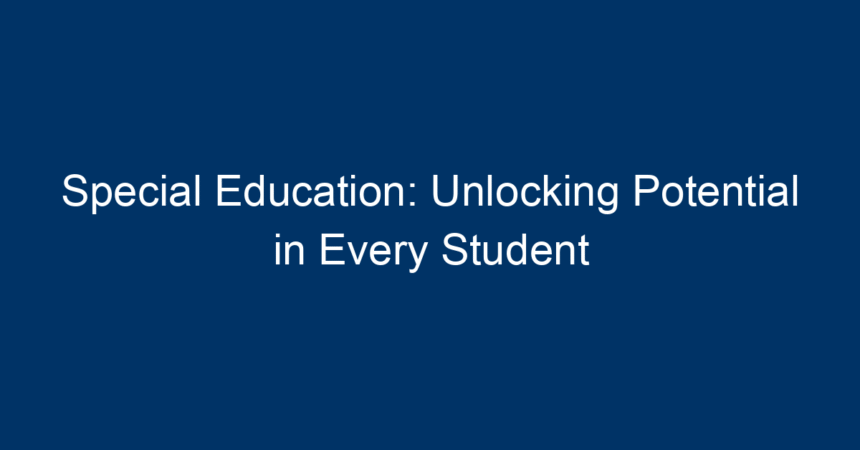Understanding the diverse needs of students is a critical aspect of today’s educational landscape. Special education plays a pivotal role in ensuring that every student, regardless of their abilities or challenges, has the opportunity to thrive academically and socially. Whether it’s through individualized learning plans or tailored support systems, special education aims to unlock potential in every student. In this article, we will explore the importance of special education, its various components, and how it can transform lives.
What is Special Education?
Special education refers to customized instructional programs designed to meet the unique needs of students with disabilities or learning challenges. Unlike traditional education systems, which generally follow a one-size-fits-all approach, special education focuses on creating a nurturing environment that accommodates varying abilities and learning styles.
Understanding Disabilities in Education
Disabilities can manifest in numerous ways, including:
- Learning Disabilities: Conditions such as dyslexia or dyscalculia that affect reading and math proficiency.
- Intellectual Disabilities: Limitations in cognitive functioning and adaptive behavior which can affect learning and social skills.
- Emotional and Behavioral Disorders: Challenges that impact emotional regulation and interpersonal relationships.
- Physical Disabilities: Conditions that limit mobility or require specific accommodations to facilitate learning.
Understanding these disabilities is crucial for teachers, administrators, and parents to effectively support students in their educational journey.
The Importance of Special Education
1. Inclusive Learning Environment
One of the primary benefits of special education is its focus on inclusivity. Students with disabilities often benefit significantly from being integrated into general classrooms, where they can interact with their peers. Inclusive environments promote acceptance, understanding, and collaboration among students of all abilities.
2. Individualized Instruction
The cornerstone of special education is the Individualized Education Plan (IEP). An IEP is a customized roadmap for each student, detailing specific educational goals, the support needed, and how progress will be measured. This level of personalization ensures that students receive instruction tailored to their unique challenges, fostering a more effective learning experience.
3. Building Life Skills
Special education goes beyond academics. It emphasizes the development of essential life skills such as communication, self-advocacy, and social interactions. Programs often incorporate activities that help students navigate real-world situations, preparing them for life beyond school.
4. Empowering Families
Families play an essential role in the success of special education. Educating parents about their child’s challenges and rights allows them to advocate effectively. Special education programs often include family involvement, ensuring that parents can support their child’s learning at home and in the community.
Components of Special Education
1. Specialized Instruction Techniques
Teachers in special education employ diverse instructional strategies tailored to individual students’ needs. Techniques may include:
- Multisensory Learning: Engaging various senses to enhance understanding, such as visual aids for students with dyslexia.
- Assistive Technology: Tools like speech-to-text software or audiobooks that facilitate learning.
- Behavioral Interventions: Techniques designed to encourage positive behavior and social skills.
2. Support Services
Various support services complement special education programs, making learning more accessible:
- Speech Therapy: Assists students with communication challenges.
- Occupational Therapy: Aims to improve daily living skills.
- Counseling Services: Provides emotional and psychological support.
3. Collaboration with General Education
Collaboration between special education teachers and general education teachers is vital for creating a cohesive learning environment. This partnership enables both parties to share strategies and resources, contributing to the overall success of students with disabilities.
Challenges in Special Education
1. Funding and Resource Allocation
One of the most significant challenges facing special education is the consistent need for adequate funding. Many schools struggle to allocate resources effectively, which can limit the quality and availability of special education services.
2. Stigma and Misunderstanding
Despite progress, a stigma still surrounds disabilities. Misunderstandings regarding the capabilities of students with disabilities can lead to lowered expectations and limitations on their educational opportunities.
3. Training for Educators
Teachers in special education require specialized training to meet the diverse needs of students. Continuous professional development is essential to equip educators with the strategies and knowledge necessary for effective teaching.
Success Stories in Special Education
Real-life Impact
For many students, special education changes lives. Success stories abound where tailored education has led to remarkable achievements. Take the example of a student with dyslexia who, through an IEP, learned to read fluently and went on to excel in writing. Or consider a student with an intellectual disability who gained independence and secured a job, contributing to their community.
Actionable Insights for Parents and Educators
1. Advocate for Your Child
Parents should actively advocate for their child’s needs within the educational system. Knowing your rights and being involved in the IEP process is crucial for ensuring your Child receives the best possible education.
2. Foster Open Communication
Maintain an open line of communication between parents, teachers, and support staff. Regular check-ins can help address issues early and ensure that strategies are adapted as needed.
3. Encourage Independence
Encouraging independence in students with disabilities supports their growth. Setting achievable goals, offering choices, and celebrating small victories can boost their confidence and motivation.
4. Engage in Community Resources
Many organizations provide support, advocacy, and resources for families involved in special education. Connecting with these organizations can offer additional tools and networks for support.
Conclusion
Special education is a vital component of our educational system, providing tools and support necessary to unlock the potential within every student. By fostering an inclusive and supportive learning environment, we can not only enhance academic achievements but also nurture social and emotional development. Understanding the various components and challenges that come with special education empowers educators, parents, and communities to create a brighter, more inclusive future for all students.
Together, we can break down barriers and celebrate the diversity of abilities, ensuring that every student has the chance to shine. Embracing special education is not just about addressing challenges; it’s about unlocking the limitless potential that resides in every child.




